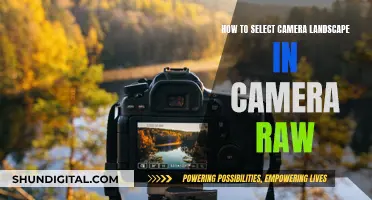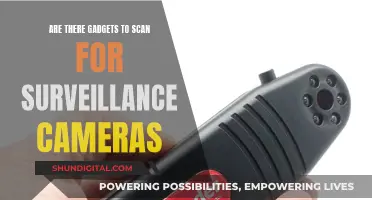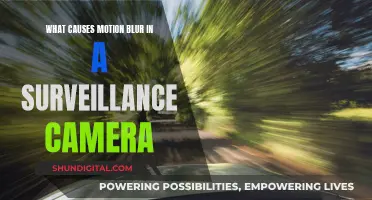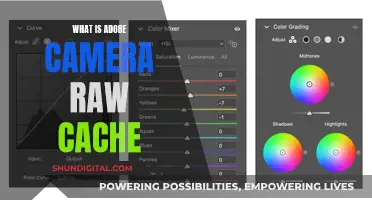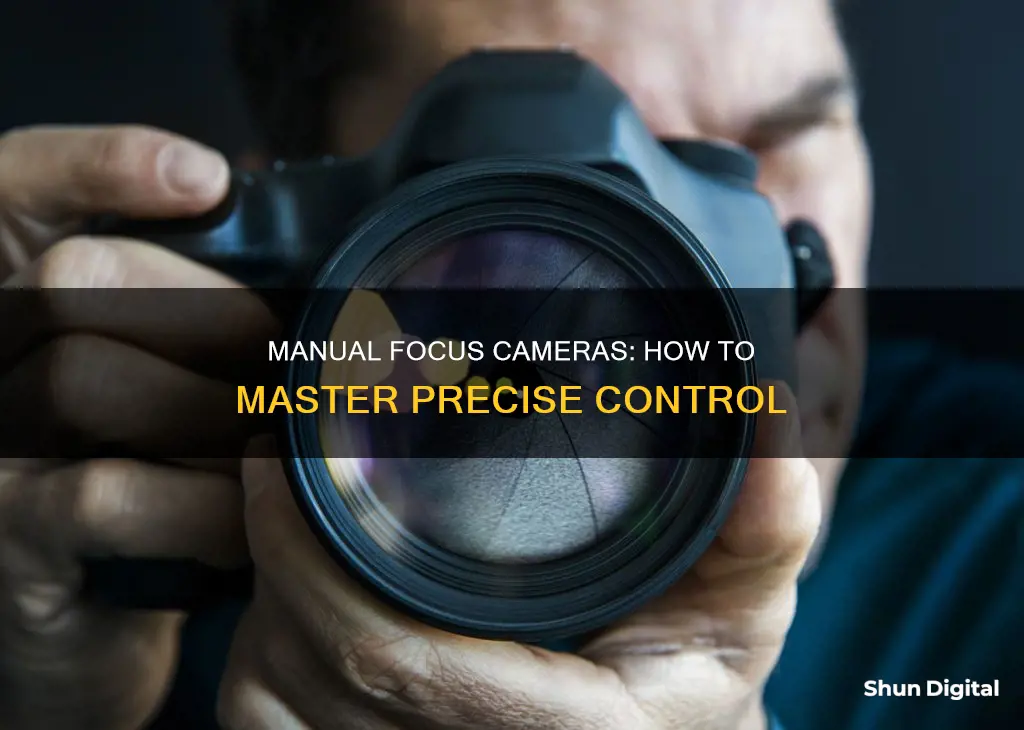
A manual focus camera is one in which the user has to adjust the focus of the lens by hand, as opposed to using autofocus. The focus is adjusted by the photographer using the focusing ring on the camera lens to achieve sharpness and clarity in their images. Manual focus is particularly useful in situations where autofocus might struggle, such as low-light conditions, complex compositions, or when the desired subject is not the closest object to the camera.
| Characteristics | Values |
|---|---|
| Definition | A method of adjusting the focus of a camera lens manually by the photographer |
| Control | The photographer takes full control over the focus adjustments, allowing for precise and intentional focusing on specific elements within the scene |
| Use Cases | Low-light conditions, complex compositions, when the desired subject is not the closest object to the camera, macro photography, shooting video, crowded settings, low contrast in the scene, shooting through an object, street photography, landscape photography |
| Tools | Focusing ring on the camera lens, Live View, focus peaking, focus distance windows, focus override, magnification of the scene |
| Limitations | Moving subjects or fast-paced scenarios, such as sports photography, wildlife photography, bird photography, event photography, and car photography |
What You'll Learn
- Manual focus gives the photographer full control over the focus adjustments
- It is useful in low-light conditions, complex compositions, or when the desired subject is not the closest object
- It is also useful for macro photography, landscape photography, and street photography
- Manual focus can be achieved by using a ring around the lens or an equivalent control on the camera body
- Some modern digital cameras can also use manual focus with an adapter

Manual focus gives the photographer full control over the focus adjustments
Manual focus is particularly useful in situations where autofocus might struggle, such as low-light conditions, complex compositions, or when the desired subject is not the closest object to the camera. It is also useful for macro photography, where precise focusing is necessary, and for creating certain effects, such as shallow depth of field.
Manual focus can be more challenging than autofocus, as it requires the photographer to have a good understanding of the camera's settings and the ability to make quick adjustments. However, it can be a valuable skill to have, as it allows for more creative control and can help to ensure that the desired subject is in focus, even in difficult lighting or composition situations.
Overall, manual focus gives the photographer full control over the focus adjustments, allowing for more intentional and precise focusing, which can lead to sharper and more creative photographs.
Evading Speeding Camera Tickets: Proving Someone Else Was Driving
You may want to see also

It is useful in low-light conditions, complex compositions, or when the desired subject is not the closest object
Manual focus is a method of adjusting the focus of a camera lens by hand, as opposed to using autofocus, which relies on the camera's built-in mechanism to focus on the subject automatically. While autofocus is a useful tool, there are certain situations in which it struggles, and manual focus is preferable.
One such situation is when shooting in low-light conditions. Autofocus systems depend on light to determine where to focus, and therefore perform poorly in low-light environments. The autofocus may struggle to lock onto a subject, or it may focus on the wrong area of the scene. With manual focus, you can precisely tell the camera where to focus, allowing you to capture clear images even in low-light conditions.
Another scenario in which manual focus is beneficial is when dealing with complex compositions or when the desired subject is not the closest object to the camera. Autofocus systems can be confused by foreground objects and may fail to capture the desired subject accurately, especially if it is in the middle or background of the scene. With manual focus, you can choose the object you want to focus on, ensuring that the right parts of your image are in focus. This is particularly useful in macro photography, where the narrow depth of field requires extreme precision in focusing.
In addition, manual focus is useful when shooting through glass or wire fences. Cameras with autofocus may struggle to focus on the desired subject and instead focus too closely on the glass or fence. With manual focus, you can avoid this issue and ensure that your subject is in focus while the foreground elements are blurred.
Overall, while autofocus is a convenient feature, there are times when manual focus is necessary to achieve the desired results. By understanding the strengths and weaknesses of both autofocus and manual focus, photographers can make informed decisions about which focusing mode to use in different situations.
Ohio Camera Tickets: Do I Have to Pay?
You may want to see also

It is also useful for macro photography, landscape photography, and street photography
Manual focus refers to a method of adjusting the focus of a camera lens by hand, as opposed to relying on the camera's autofocus mechanism. The photographer takes full control over the focus adjustments, allowing for precise and intentional focusing on specific elements within the scene. This technique is particularly useful in situations where autofocus might struggle, such as low-light conditions, complex compositions, or when the desired subject is not the closest object to the camera.
Manual focus is also useful for macro photography, where the photographer deals with a shallow depth of field, diffraction, and motion blur. In such cases, autofocus systems often struggle to focus on tiny, fast-moving subjects. The proper way to focus manually for macro photography is to set the lens to its closest focusing distance and then slowly move forward and backward until the subject appears sharp in the viewfinder. This technique ensures that the photographer captures the small subject in focus, as even a slight movement can cause the image to blur.
Manual focus is also beneficial for landscape photography, especially when dealing with complex compositions or low-light conditions that challenge autofocus systems. In landscape photography, the "double the distance" method is often used to achieve equal foreground and background sharpness. This involves focusing at a point twice as far away as the closest object in the frame, ensuring that both the foreground and background are equally sharp. In situations where autofocus struggles or when the photographer desires more creative control, manual focus can be employed to achieve the desired results.
Additionally, manual focus is advantageous for street photography, as it offers greater speed and control compared to autofocus. With manual focus, photographers can quickly guess the approximate best focus point and make decisions more swiftly. This is especially true in good lighting conditions, as it allows shooting at small apertures like f/8 or f/11, resulting in a larger depth of field. By utilising zone focusing and hyper-focal distance techniques, street photographers can pre-set the focus distance and capture decisive moments without the need for autofocus.
Mastering Samsung Camera Focus: Tips and Tricks
You may want to see also

Manual focus can be achieved by using a ring around the lens or an equivalent control on the camera body
Manual focus is a method of adjusting the focus of a camera lens by hand, as opposed to using autofocus. When operating in manual focus mode, the photographer takes full control over the focus adjustments, allowing for precise and intentional focusing on specific elements within the scene. This technique is particularly useful in situations where autofocus might struggle, such as low-light conditions, complex compositions, or when the desired subject is not the closest object to the camera.
In addition to the focus ring, some lenses also have a focusing mode switch labelled "AF/MF", allowing the user to switch between autofocus and manual focus modes. This switch is usually found on the lens or the camera body. It is important to ensure that the camera or lens is set to the manual focus option before attempting to adjust the focus manually.
The process of manual focusing involves looking through the camera's viewfinder or the LCD display and twisting the focus ring until the desired subject comes into focus. The photographer can then make further adjustments as needed to ensure optimal sharpness and clarity in the image.
Manual focus is particularly useful in scenarios such as macro photography, low-light conditions, crowded settings, and shooting "through" an object, where autofocus may struggle or focus on the wrong subject. It gives photographers complete control over the focus of their images and allows them to achieve precise and intentional results.
The Origin Story of SpyPoint Cameras
You may want to see also

Some modern digital cameras can also use manual focus with an adapter
Manual focus is a method of adjusting the focus of a camera lens by hand, as opposed to using autofocus. Photographers use the focusing ring on the camera lens to achieve sharpness and clarity in their images. While autofocus is great, there are certain situations where it struggles. It may lock focus on the wrong parts of a scene, or it may fail to lock focus completely.
Manual focus lenses can also be used on modern digital cameras with an adapter. Manufacturers such as Zeiss, Leica, and Cosina Voigtländer continue to make manual lenses in lens mounts native to modern cameras.
Using an adapter, photographers can use older manual focus lenses on modern digital cameras. This allows photographers to take advantage of the advanced features and image quality offered by modern digital cameras while still being able to use their favourite manual focus lenses.
In addition, some modern digital cameras offer a "Live View" feature, which can be extremely helpful when using manual focus. "Live View" allows photographers to see a live image from the sensor on the camera's LCD screen, making it easier to adjust the focus manually.
By using manual focus with an adapter on a modern digital camera, photographers can have more control over the focus of their images and utilise vintage lenses that may offer unique optical characteristics not found in modern lenses.
The Evolution of Computer Cameras: How Are They Made?
You may want to see also
Frequently asked questions
A manual focus camera is one in which the user has to adjust the focus of the lens by hand, rather than relying on the camera's built-in autofocus mechanism.
On the side of your lens, look for a switch labelled "AF/MF" for Autofocus/Manual Focus. When you're ready to shoot in MF mode, switch your lens to that setting.
You can use manual focus whenever you like, but it is particularly useful in low-light conditions, complex compositions, or when the desired subject is not the closest object to the camera. It is also useful for macro photography, crowded settings, street photography, and landscape photography.
Once you've set the camera or lens to the manual focus option, simply turn the focusing ring and watch what happens in the viewfinder or on the LCD screen. When you get to the point where your subject is in focus, stop turning the ring and take the picture.



